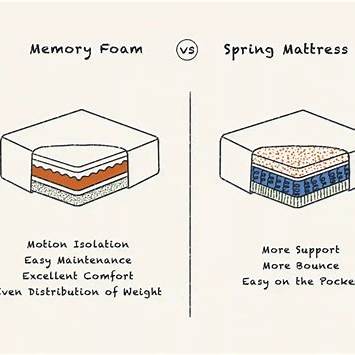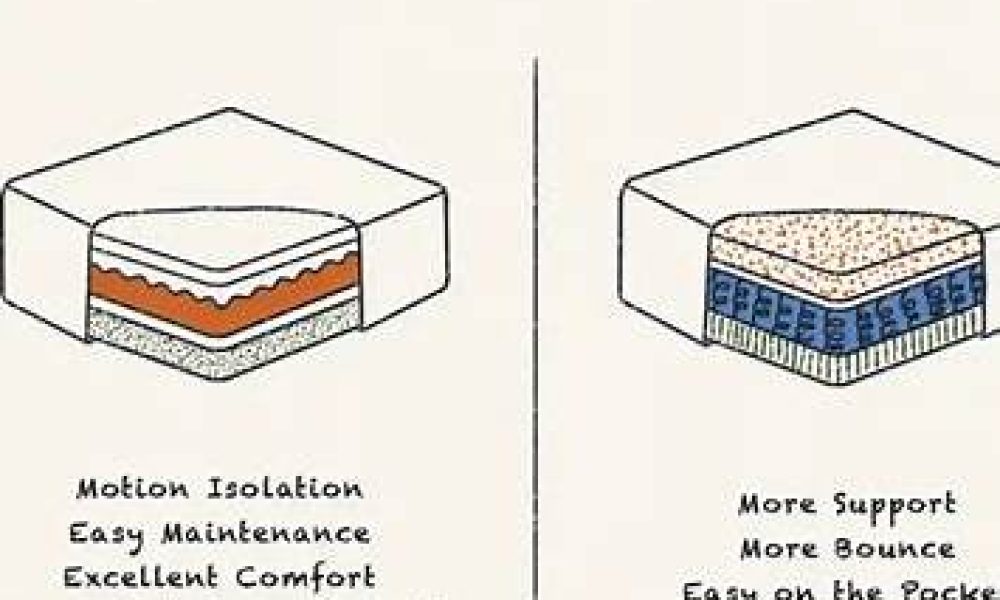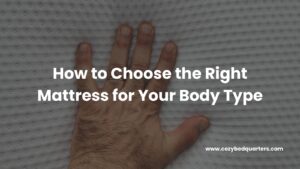Memory Foam Mattress vs Spring: Honest Pros & Cons Guide
Choosing between a memory foam mattress vs spring comes down to how you like to sleep: contouring pressure relief and quiet motion, or cool bounce with easier movement. Here’s the no-fluff breakdown.
Key Takeaways on Memory Foam Mattress vs Spring
- Memory foam mattress vs spring is a tradeoff: contouring + motion isolation vs bounce + airflow.
- Memory foam suits side/back sleepers needing pressure relief; springs suit hot sleepers and those who change positions often.
- Both can be eco-friendly — look for CertiPUR-US, GOTS, or OEKO-TEX certifications.
- Durability varies by foam density, coil type, and edge support — quality matters more than type.
Understanding the Basics
Answer first: Memory foam molds to you; springs push back and breathe better. Knowing construction helps you match feel to your sleep style.
What Is a Memory Foam Mattress?
A memory foam mattress uses viscoelastic foam that softens with heat and pressure for close contouring. Variations include plant-based and gel-infused foams for cooler sleep. If you want a deeper dive, see our guide on memory foam comfort and support and mattress care.
- Body-contouring support
- Excellent motion isolation
- Slow responsiveness; may retain heat without cooling tech
What Is a Spring Mattress?
Spring (innerspring) mattresses use steel coils — Bonnell, continuous, or pocketed. Pocket coils isolate movement better and often include comfort foams or natural fibers on top.
- Responsive, bouncy feel with easier movement
- Better airflow and cooler sleep
- More motion transfer in cheaper, non-pocketed designs
Side-by-Side: Spring vs Memory Foam Mattress
Answer first: Foam wins pressure relief and quiet; springs win cooling and bounce. The right pick depends on your body and room climate.
Comfort & Body Support
Memory foam: Cradles hips/shoulders for pressure relief — great for side/back sleepers. Some find the “hug” too enveloping.
Spring: Buoyant, sleeps more “on” than “in,” and makes position changes easier.
Verdict: Choose memory foam for deep contouring; choose spring for a firmer, buoyant feel.
Motion Transfer
Memory foam: Excellent isolation for couples and light sleepers.
Spring: Pocket coils help, but basic coil systems transfer movement.
Verdict: Foam wins for motion isolation. See tips in Motion Transfer Reduction: Ideal for Couples.
Temperature Regulation
Memory foam: Can trap heat unless designed with gel, open-cell, or phase-change tech.
Spring: Naturally airy through the coil core; typically sleeps cooler.
Verdict: Springs generally run cooler unless you invest in advanced cooling foams.
Durability & Lifespan
Memory foam: Quality, density, and layer thickness determine longevity (often 8–10 years for good builds).
Spring: Pocket coils wear more evenly; reinforced edges improve structure (about 7–12 years depending on build).
Verdict: It’s a draw — compare foam density and coil type/coil count, not just brand.
Smell & Off-Gassing
Memory foam: Some new-mattress smell (VOCs) that dissipates; choose CertiPUR-US for lower emissions.
Spring: Minimal odor; any scent usually from foam layers/packaging.
Verdict: Springs typically have less noticeable odor.
Eco-Friendliness
Memory foam: Look for plant-based foams and CertiPUR-US.
Spring: Steel coils are recyclable; many models add organic cotton/wool.
Verdict: Both can be eco-conscious — materials and certifications matter most.

Memory Foam vs Spring Mattress: Pros & Cons
Answer first: Foam = contouring/quiet. Springs = cool/bouncy. Pick based on pressure relief vs temperature and mobility.
Memory Foam Mattress
- Excellent contouring for joints
- Absorbs partner movement
- Quieter than coils
- Luxurious, cushioned feel
- May trap heat without cooling features
- Initial “new foam” smell
- Slower rebound
- Can feel too soft for heavier sleepers (check density)
Spring Mattress
- Firmer, more buoyant support
- Sleeps cooler due to airflow
- Easier to move around
- Edge support often stronger
- Noticeable motion transfer in cheaper builds
- Potential squeaks over time
- Pressure points if comfort layers are thin

Real-Life Snapshots
- Emma (36), side sleeper: Switched from firm spring to medium memory foam — less morning stiffness in a week. See our memory foam support guide.
- Hamza (29), hot sleeper: Returned hot foam and chose a breathable hybrid for cooler recovery after workouts.
- Fatima & Amir, light sleepers: Foam bed-in-a-box solved motion wake-ups.
Design & Decor Tips
Memory foam style: Minimal, low-profile frames; neutral palettes; bamboo or organic cotton bedding.
Spring style: Timeless frames and layered textiles; see wood bed frames in traditional settings.
Eco tip: Choose organic sheets, recycled frames, or reclaimed-wood headboards.
FAQs
- Is memory foam better than spring?
- It depends. Memory foam excels at pressure relief and motion isolation. Springs offer cooling and bounce for easier movement.
- Can memory foam mattresses cause back pain?
- Yes, if the firmness is mismatched. Medium-firm models usually balance contouring and support well.
- Which mattress type is more sustainable?
- Both can be eco-friendly — look for CertiPUR-US foam and GOTS/OEKO-TEX textiles.
- Do memory foam beds sag?
- Lower-density foams sag sooner. Choose higher density in the comfort/support layers to extend life.
- Is a spring mattress better for heavy people?
- Often yes, due to stronger edge support and buoyant feel. Consider pocket coils with robust gauge and a quality comfort layer.
Final Thoughts
There’s no single winner in the memory foam mattress vs spring debate — pick contouring and quiet or cooling and bounce. For easy care, see how to clean a memory foam mattress, and start planning your bedroom refresh at Cozy Bed Quarters.
Related reading from Cozy Bed Quarters
- Exploring Modern Bed Types: A Comprehensive Guide
- Stylish Bed Frames to Elevate Your Bedroom Decor
- Gold Canopy Bed: Elegant Luxury
Other reading we found popular























